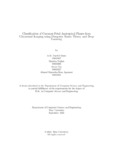| dc.contributor.advisor | Alam, Md. Golam Rabiul | |
| dc.contributor.author | Islam, A.M. Tayeful | |
| dc.contributor.author | Nujhat, Marshia | |
| dc.contributor.author | Roy, Atanu | |
| dc.contributor.author | Agomoni, Ahmed Mayeesha Reza | |
| dc.date.accessioned | 2023-10-15T04:08:21Z | |
| dc.date.available | 2023-10-15T04:08:21Z | |
| dc.date.copyright | ©2022 | |
| dc.date.issued | 2022-09-29 | |
| dc.identifier.other | ID 19101107 | |
| dc.identifier.other | ID 19101100 | |
| dc.identifier.other | ID 19101267 | |
| dc.identifier.other | ID 19101181 | |
| dc.identifier.uri | http://hdl.handle.net/10361/21801 | |
| dc.description | This thesis is submitted in partial fulfillment of the requirements for the degree of Bachelor of Science in Computer Science and Engineering, 2022. | en_US |
| dc.description | Cataloged from PDF version of thesis. | |
| dc.description | Includes bibliographical references (pages 34-36). | |
| dc.description.abstract | Ultrasound (US) examination is a widely used important instrument to monitor
mother and fetus health in a cost-effective and non-invasive way. The acquisition
of Ultrasound (US) images to determine vital fetal organs for the screening of fetal
abnormalities requires identifying the exact plane and region of the desired organs.
Even after following guidelines from appropriate committees, a sonologist some-
times may have difficulties in acquiring an excellent fetal plane image or make errors
in judgement for several reasons like inexperienced operators, faulty equipment or
movement of the fetus. Furthermore, sometimes due to the fetus being in critical
positions or due to the increase of adipose tissue inside the mother, it can create
various problems in the imaging like artifacts, acoustic shadows or even low signal
to noise ratio. Also, in an appropriate institute, a specialist of fetal images reviews
the sonographer’s analysis and chooses images that contains structures of interest
which later gets reviewed by a senior maternal-fetal expert or a specialist doctor.
This is a manual process which is expensive, cumbersome and sensitive to mistakes.
So we propose a method that combines Convolutional Neural Network (CNN) and
Dempster-Shafer theory (DST) to create a DST based evidential classifier or evidential CNN called E-CNN for the classification of common fetal anatomical planes like brain, abdomen, thorax, femur as well as the maternal cervix from its ultrasound images. | en_US |
| dc.description.statementofresponsibility | A.M. Tayeful Islam | |
| dc.description.statementofresponsibility | Marshia Nujhat | |
| dc.description.statementofresponsibility | Atanu Roy | |
| dc.description.statementofresponsibility | Ahmed Mayeesha Reza Agomoni | |
| dc.format.extent | 48 pages | |
| dc.language.iso | en | en_US |
| dc.publisher | Brac University | en_US |
| dc.rights | Brac University theses are protected by copyright. They may be viewed from this source for any purpose, but reproduction or distribution in any format is prohibited without written permission. | |
| dc.subject | Ultrasound (US) images | en_US |
| dc.subject | Convolutional Neural Network (CNN) | en_US |
| dc.subject | Dempster- Shafer theory (DST) | en_US |
| dc.subject | Evidential classifier | en_US |
| dc.subject | E-CNN | en_US |
| dc.subject | Classification | en_US |
| dc.subject | Common fetal anatomical planes | en_US |
| dc.subject.lcsh | Neural networks (Computer science) | |
| dc.subject.lcsh | Machine learning | |
| dc.title | Classification of common fetal anatomical planes from ultrasound imaging using dempster shafer theory and deep learning | en_US |
| dc.type | Thesis | en_US |
| dc.contributor.department | Department of Computer Science and Engineering, Brac University | |
| dc.description.degree | B.Sc. in Computer Science | |

